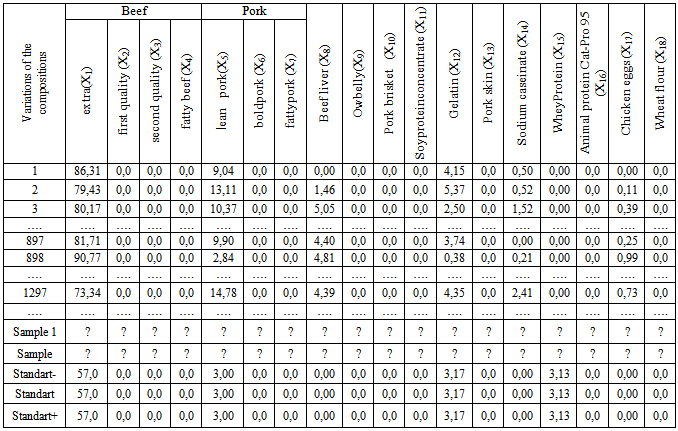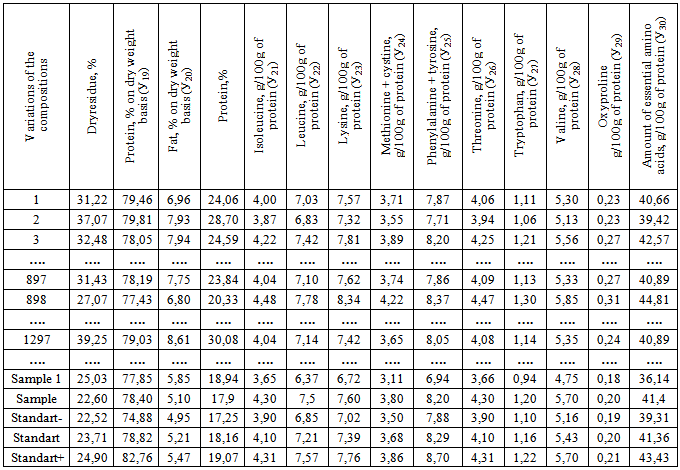-
Paper Information
- Next Paper
- Previous Paper
- Paper Submission
-
Journal Information
- About This Journal
- Editorial Board
- Current Issue
- Archive
- Author Guidelines
- Contact Us
Advances in Life Sciences
p-ISSN: 2163-1387 e-ISSN: 2163-1395
2014; 4(2): 82-87
doi:10.5923/j.als.20140402.08
The Assessment of Food Composition Conformity with the Recipes’ Requirements
Vladimir Sadovoy1, 2, Arcady Silantyev3, Tatiana Shchedrina1, Elena Savelieva2
1North-Caucasian Federal University, Pyatigorsk, Russia
2Stavropol Institute of Cooperatives (branch) BUCEP, Stavropol, Russia
3Povolzhskiy State University of Telecommunications and Informatics, Stavropol, Russia
Correspondence to: Vladimir Sadovoy, North-Caucasian Federal University, Pyatigorsk, Russia.
| Email: |  |
Copyright © 2014 Scientific & Academic Publishing. All Rights Reserved.
On the basis of the analysis of the chemical and amino acid compositions of raw materials with the using of cluster analysis and neural networks, called Kohonen maps, developed a method of assessing prescription of regulatory requirements. The developed technique was tested in the analysis of prescription of meat products.
Keywords: Food products, Regulatory requirements, Cluster analysis, Meat products, Chemical composition, Amino acid composition
Cite this paper: Vladimir Sadovoy, Arcady Silantyev, Tatiana Shchedrina, Elena Savelieva, The Assessment of Food Composition Conformity with the Recipes’ Requirements, Advances in Life Sciences, Vol. 4 No. 2, 2014, pp. 82-87. doi: 10.5923/j.als.20140402.08.
Article Outline
1. Introduction
- In the recent years, food-processing companies have been producing foods that are often below the required quality standards. Adding various food additives as a way to boost revenue has become commonplace. The vast majority of formulations substitutelow-grade ingredients for higher quality materials, using additives of unverified composition from various manufacturers. Practice shows that such food products are usually of lower quality compared to those produced in compliance with the regulatory requirements. Quality issues are especially serious when it comes to such products as cooked sausage, semi-smoked sausage, and cooked-and-smoked sausage. Thus follows the importance of protecting the interests of both manufacturers and consumers in an equal fashion, balancing out the accepted risks of food consumption and the possibilities connected to the scientific, technological and economical level of development. It is necessary to provide also that the quality of the products delivered to the store counters meets the guaranteed standards.The current quality standards specify the requirements based on the microbiological and organoleptic (appearance, texture, appearance on the cut, smell, taste, color, shape, size) properties, as well as some physiochemical parameters (protein, fat and moisture content, and other indicators). These indicators, however, while important, do not allow the accurate identification of the product. Developing a method for quality assessment of food products determining whether they meet the regulatory requirements will protect consumers from substandard products.Research objective is working outa method of quality assessment for food products, to validate this method by analyzing cooked sausage products to confirm their compliance with regulatory requirements.
2. Materials and Methods
- All statistical and mathematical modelling is implemented Statistic v. 10, Statistical Neural Networks v. 4, 10 and algorithmic language Pascal. The preliminary phase carried out an analysis to determine the chemical and amino acid composition of the raw materials used in sausage production: beef and lean pork (all grades), beef liver, fat, pork belly, pork skin, isolated and concentrated soy protein preparations, sodium case in ate, animal protein Cat-Pro 95, soy flour, chicken eggs, and wheat flour.Based on the amount of the analyzed components, the mixture model was created, and factor variability intervals were pre-set. In the planning matrix, the dimensionless characteristics were substituted for natural values. The planning metrics data was run through a program developed in Pascal to create a component array where the factor scores were calculated assuming that the sum of the raw material components in the formulation equaled 100%. The component array included 17,026 variations of mixture compositions. For each variation, solids, protein and fat (including calculations on a dry basis) content was calculated, as well as amino acid composition (based on essential amino acids and oxyproline), sum of essential amino acids (EAA), and tryptophan: oxyproline ratio. Oxyproline monitoring is necessary to determine the presence of connective tissue in meat products and gives the opportunity to determine whether the formulation meets the standard requirements regulating the quantities of graded lean meats and food additives in the product.Protein and fat content indicators (in % on a dry basis) determine the possibility of using various carbohydrate- protein supplements and help establish whether the formulation meets the regulatory requirements for quantitative graded pork meat content.Amino acid composition indicates the formulation ratio for raw materials containing protein fraction, as each of the ingredients used in the formulation has a specific set of amino acids.
3. Results and Discussions
3.1. Development of Composition’s Model
- Until recently a decision on optimization options were passed without special studies, only on the basis of the experience and common sense. However, the more complex became a system of requirements to the final product, the less valid approximate solutions and the greater significance of special methods to evaluate the advantages and disadvantages of each option.To validate the effectiveness of the developed method, a sample was manufactured using the formulation for top grade cooked sausage (kolbasavarenaya) “Stolichnaya”. Allowing a margin for error in experimental studies (accepted margin for process design compilations being 5%), chemical and amino acid compositions were calculated for the given product. On entrance variables of a matrix of planning and investigated indicators the architecture of a neural network is developed. The laboratory analysis results and calculated indicators were recorded in the database consisting of component array and functional indicators which calculated by means of a neural network that measure the given meat product’s compliance with the regulatory requirements (table 1, 2).
|
|
3.2. Assessment of the Conformity of the Composition
- The array data (table 2) were clusted using Kohonen neural networks [1, 2] to determine the recipes’ compliance of manufactured sample with the requirements of developed technical documentation (Fig. 1, 2).
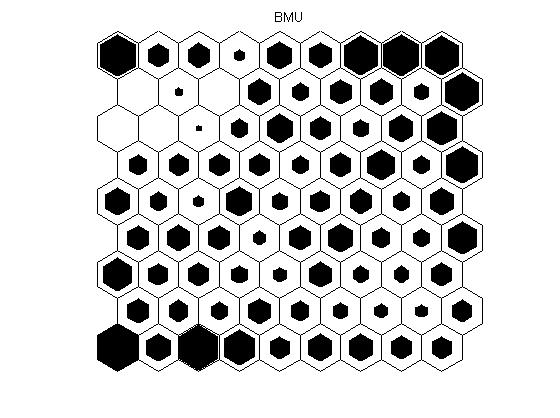 | Figure 1. Parameters of the neural network maps |
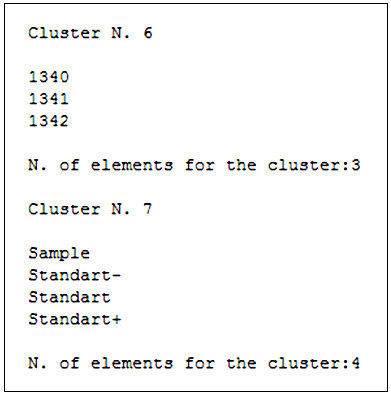 | Figure 2. Fragment of listing clustering results |
 | Figure 3. Results of Analyzed Variations Clustering3 |
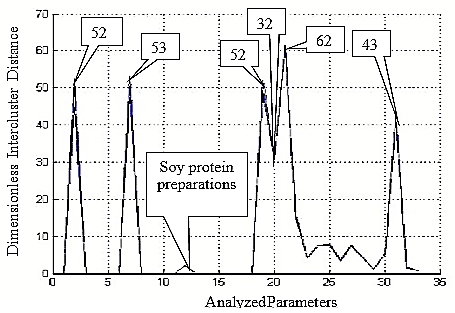 | Figure 4. Qualitative Characteristics Evaluation of the Analyzed Compositions |
 | Figure 5. Kohonen map review of the conformity of meat recipes regulatory requirements |
4. Conclusions
- As a result of the analytical and empirical research paired with the existing methods of quality assessment of food products, the framework for defining how the formulations of the analyzed products match the standard requirements is proposed.
Notes
- 1. Contents of the components in the formulation given in kg per 100 kg of the basic raw material.The structure of meat raw materials is resulted according to standards of the Russian Federation.2. The chemical composition of the test sample formulation (Sample), obtained as a result of the experiment, recalculated without added fiber and moisture in preparing the stuffing.3. The range of analyzed parameters includes components of the compositions in accordance to their ordinal number in table 1 (1 – 18) and functional indicators set in order of their position in table 2 (left to right): 19, 20 – protein and fat content in % on solids basis; 21 – 29 amino acid composition by essential amino acids and oxyproline (g/100g protein); 30 – EAA sum (g/100g protein); 31 – connective tissue composition indicator (tryptophan: oxyproline).
 Abstract
Abstract Reference
Reference Full-Text PDF
Full-Text PDF Full-text HTML
Full-text HTML